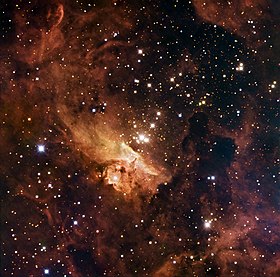Pismis 24-1
 Pismis 24-1 is the brightest region of light at the centre of this optical image of the NGC 6357 region. Credit: ESO/IDA/Danish 1.5 m/ R. Gendler, U.G. Jørgensen, J. Skottfelt, K. Harpsøe | |
| Characteristics | |
|---|---|
| NE | |
| Spectral type | O3.5If*[1] |
| Variable type | eclipsing[2] |
| SW | |
| Spectral type | O4III(f+)[1] |
| Astrometry | |
| Radial velocity (Rv) | −2.0[3] km/s |
| Proper motion (μ) | RA: −0.1[4] mas/yr Dec.: −1.3[4] mas/yr |
| Distance | 6,500[5] ly (2,000[5] pc) |
| Absolute magnitude (MV) | −7.50[1] |
| NE | |
| Absolute magnitude (MV) | −6.41[2] |
| SW | |
| Absolute magnitude (MV) | −6.28[2] |
| Details | |
| NE | |
| Mass | 74[6] M☉ |
| Radius | 18 R☉ |
| Luminosity | 776,000[6] L☉ |
| Temperature | 42,500/41,500[2] K |
| SW | |
| Mass | 66[6] M☉ |
| Radius | 17 R☉ |
| Luminosity | 646,000[6] L☉ |
| Temperature | ~40,000[6] K |
| Other designations | |
| NE: Pismis 24-1NE, HD 319718A | |
| SW: Pismis 24-1SW, HD 319718B | |
| Database references | |
| SIMBAD | data |
Pismis 24-1 (also known as HD 319718) is the brightest star in the Pismis 24 open cluster in the NGC 6357 nebula. It is 6,500 light years away. It was thought to be the most massive star known: actually it is made of three stars. These are still some of the most luminous and most massive stars known.
References[change | change source]
- ↑ 1.0 1.1 1.2 Maíz Apellániz, J.; Walborn, Nolan R.; Morrell, N. I.; Niemela, V. S.; Nelan, E. P. (2007). "Pismis 24-1: The Stellar Upper Mass Limit Preserved". The Astrophysical Journal. 660 (2): 1480–1485. arXiv:astro-ph/0612012. Bibcode:2007ApJ...660.1480M. doi:10.1086/513098. S2CID 15936535.
- ↑ 2.0 2.1 2.2 2.3 Barr Domínguez, A.; Chini, R.; Pozo Nuñez, F.; Haas, M.; Hackstein, M.; Drass, H.; Lemke, R.; Murphy, M. (2013). "Eclipsing high-mass binaries. I. Light curves and system parameters for CPD - 51° 8946, PISMIS 24-1, and HD 319702". Astronomy & Astrophysics. 557: A13. arXiv:1306.5482. Bibcode:2013A&A...557A..13B. doi:10.1051/0004-6361/201321642. S2CID 118623790.
- ↑ Crampton, D. (1972). "Radial velocities of southern B stars determined at the Radcliffe Observatory - VI. Stars in H II regions". Monthly Notices of the Royal Astronomical Society. 158: 85–98. Bibcode:1972MNRAS.158...85C. doi:10.1093/mnras/158.1.85.
- ↑ 4.0 4.1 Høg, E.; Fabricius, C.; Makarov, V. V.; Urban, S.; Corbin, T.; Wycoff, G.; Bastian, U.; Schwekendiek, P.; Wicenec, A. (2000). "The Tycho-2 catalogue of the 2.5 million brightest stars". Astronomy and Astrophysics. 355: L27. Bibcode:2000A&A...355L..27H. doi:10.1888/0333750888/2862.
- ↑ 5.0 5.1 Lima, E. F.; Bica, E.; Bonatto, C.; Saito, R. K. (2014). "Probing embedded star clusters in the HII complex NGC 6357 with VVV". Astronomy & Astrophysics. 568: A16. arXiv:1406.2413. Bibcode:2014A&A...568A..16L. doi:10.1051/0004-6361/201323050. S2CID 56229887.
- ↑ 6.0 6.1 6.2 6.3 6.4 Fang, M.; Van Boekel, R.; King, R. R.; Henning, T.; Bouwman, J.; Doi, Y.; Okamoto, Y. K.; Roccatagliata, V.; Sicilia-Aguilar, A. (2012). "Star formation and disk properties in Pismis 24". Astronomy & Astrophysics. 539: A119. arXiv:1201.0833. Bibcode:2012A&A...539A.119F. doi:10.1051/0004-6361/201015914. S2CID 73612793.
